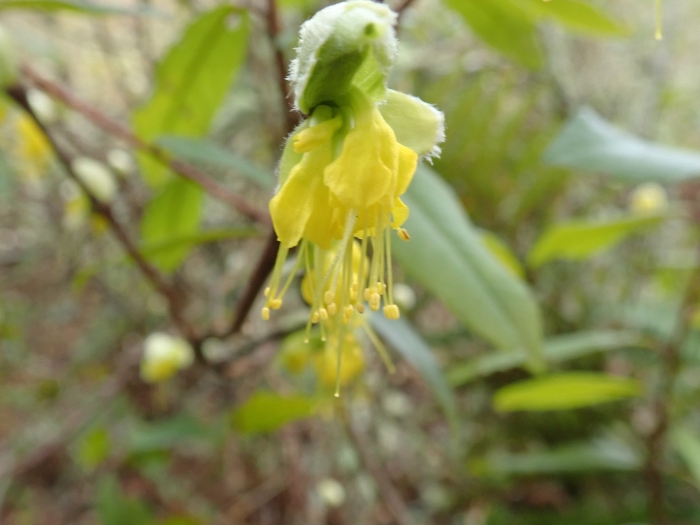Western Leatherwood
(Dirca occidentalis)
Western Leatherwood (Dirca occidentalis)
/
/

joergmlpts
CC BY 4.0
Image By:
joergmlpts
Recorded By:
Copyright:
CC BY 4.0
Copyright Notice:
Photo by: joergmlpts | License Type: CC BY 4.0 | License URL: http://creativecommons.org/licenses/by/4.0/ | Rights Holder: joergmlpts | Publisher: iNaturalist | Date Created: 2020-01-24T09:51:14-08:00 |

























Estimated Native Range
Summary
Dirca occidentalis, commonly known as Western Leatherwood, is a deciduous shrub native to the chaparral and woodland margins of the San Francisco Bay area in California. It is typically found in moist, shaded slopes and canyons, often in association with coast live oak and California bay laurel. This shrub is rare and has a restricted distribution within its native range. Western Leatherwood typically grows to a height of 3-6 feet (0.9-1.8 meters) and has a similar spread. It features smooth, flexible branches with simple, alternate leaves that are 1-3 inches long. The plant is noted for its small, yellow flowers that bloom in early spring before the leaves emerge, adding a splash of color to the landscape.
Western Leatherwood is valued for its early spring flowers and its ability to thrive in the dappled shade of woodland gardens. It is used in native plant gardens and restoration projects within its range. The shrub prefers well-drained soils and requires moderate water, especially during dry summer months. It is tolerant of part shade conditions and can adapt to a variety of soil types, provided they are not too alkaline. There are no popular garden cultivars due to its rarity and specialized habitat requirements. Potential problems include limited availability in nurseries and sensitivity to habitat disturbance.CC BY-SA 4.0
Western Leatherwood is valued for its early spring flowers and its ability to thrive in the dappled shade of woodland gardens. It is used in native plant gardens and restoration projects within its range. The shrub prefers well-drained soils and requires moderate water, especially during dry summer months. It is tolerant of part shade conditions and can adapt to a variety of soil types, provided they are not too alkaline. There are no popular garden cultivars due to its rarity and specialized habitat requirements. Potential problems include limited availability in nurseries and sensitivity to habitat disturbance.CC BY-SA 4.0
Plant Description
- Plant Type: Shrub
- Height: 6-10 feet
- Width: 6-10 feet
- Growth Rate: Slow
- Flower Color: Yellow
- Flowering Season: Spring
- Leaf Retention: Deciduous
Growth Requirements
- Sun: Part Shade, Full Shade
- Water: Low, Medium
- Drainage: Medium
Common Uses
Bee Garden, Bird Garden, Low Maintenance
Natural Habitat
Native to chaparral and woodland margins of the San Francisco Bay area
Other Names
Common Names:
Scientific Names: , Dirca occidentalis,
GBIF Accepted Name: